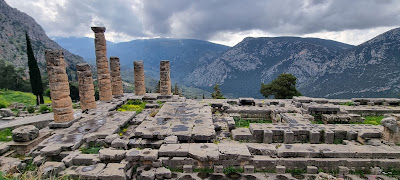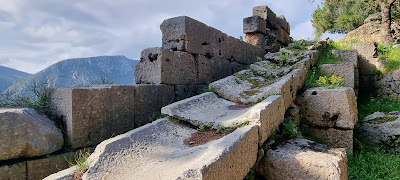31 March 2025 – Delphi
Miles
driven today = 69
Total Miles
to date = 2,620
Up until about an hour ago I had some really exciting news to share with you. Avid readers of this blog will be aware that despite having owned our van for more than 3 years now, we still haven’t come up for a name for it which we can both agree on. Then a few days ago Lisa had a brainstorm. Why not call it Delfi, as in Delfi Dethleffs. Bingo! But I thought we would wait until we had actually visited Delphi (the “ph” and “f” spellings are interchangeable) before announcing this to the World. Except Lisa has now decided that the van is in fact male, and so we are back to square 1!
Having seen the lack of parking space around the archeological site when we passed it yesterday we decided to get ourselves up and away as quickly as we possibly could this morning and then have a rather more leisurely breakfast once we were already parked up nearby.
A very quick history lesson. The Oracle at Delphi was perhaps the most holy site to the ancient Greeks. The serpent Python, son of the Goddess Gaia, was believed to live in a rock chasm here until he was slain by Apollo. But it was nevertheless believed that Python and other Gods could still communicate with the living World and bestow their wisdom in the form of strange vapours which exuded from the chasm. The prophecies were relayed by The Pythean Priestess and interpreted by priests, who I guess could have made up any old twaddle but were nevertheless highly revered and extremely well educated for the time, with networks of informants across the Realm. Huge decisions, such as whether or not to commence wars were taken based on the prophecies and, as I saw the other day, the decision to make the Acropolis in Athens purely a place for the Gods to reside was also taken here. A large and extremely rich sanctuary therefore developed around the Oracle.
The majority of the site is visited by following the “Sacred Way”. A steep path which zigzags up through the site. The first site we see is the Monument of the Admirals which once contained 37 bronze statues of Gods and Generals. The marble columns are a Roman addition.
I found out a lot more about “Treasuries” at Delphi. We had seen these previously at Olympia and I misunderstood their meaning. Each one was in fact set up by individual city states or islands and filled with votive treasures and offerings, which in many ways were the sponsor’s way of showing off their wealth. We would get to see some of the treasures later in the museum.
The Sacred Omphalos or Navel was believed to have been a stone thrown by Zeus to mark Delphi as being the centre of the World. It also marked Python’s tomb. I’m fairly certain that this is a cast of the original.
The Athenian Treasury is the best preserved building on the site. It was pieced back together in the early 20th century by matching up the inscriptions which are carved into many of the stones like a very large jigsaw.
The Athenian Stoa contained trophies from a naval victory in 506 BC. Behind that you can see the “Polygonal Wall” made of interlocking stones which has remained intact since its construction, despite several intervening Earthquakes.
The Polygonal Wall is also covered in inscriptions, many of which refer to the emancipation of slaves, which could only be officially registered at Delphi.
The twisted bronze pillar here are the tails of three intertwined serpents whose heads once held a gold tripod. The tripod was melted down by the Phocians during a Sacred War but the Serpents were carted off to the Hippodrome in Constantinople in 330 AD, where they remain to this day.
The plinth
next to it supported a gilded chariot of the Sun God Ilios, which was a votive
from the island of Rhodes.
The prime location in the Sanctuary is taken by the Temple of Apollo, God of Music, Harmony and Light (maybe we should call the van “Apollo”).
The partially restored colonnade we can see today dates back to the 4th Century BC but there were 2 earlier Temples previously built on this same site.
I presumed that this was some form of drainage channel.
The Delphic Theatre was originally constructed in the 4th Century BC but what we see today is the result of Roman alterations of the 1st Century AD. The Theatre had a capacity of 5,000 spectators.
Fantastic view looking down from the top of the Theatre and over the Temple of Apollo.
Much like Olympia and Epidaurus, Delphi hosted periodic games. The Stadium’s racetrack was originally created in the 5th Century BC. The marble seating was added under the rule of Emperor Hadrian in the 2nd Century AD.
The track was one Pythean Stade (178 metres) long and was wide enough for as many as 18 athletes to race at one time.
Having made our way all the way back down the hill through the site we headed for the Museum. I know what you’re thinking. More old pottery and model horses. But there was some incredible stuff here. This is the Winged Sphinx of the Naxians from 565 BC.
One of the Temple friezes depicting a battle between the Olympians and the Giant Children of Gaia.
A pair of marble “Kuroi” from Argos (the city, not the shop) and dated 580 BC.
Statues thought possibly to be of Apollo. The bodies would have been wooden but the exposed parts like faces and arms were made of ivory, which has been blackened by time. Hair, clothes and jewelry were made of gold.
A life size bull measuring 2.3 metres in length and made of silver sheeting.
A “kylix” found in a tomb which depicts Apollo playing a lyre. 480 BC.
This just blew me away. This is a hymn to Apollo complete with musical notations for lyre, flute and a stringed instrument called a cithara. It was created in 128 BC and as such is the oldest known written record of a musical melody.
Statue of Antinoos, who was a beloved companion of Emperor Hadrian and acquired Demi-God status despite the fact he drowned in the Nile in 130 AD before reaching adulthood.
And here he is being dug out of the ground by a team of French Archeologists in 1891.
Finally, the crème de la crème. This is The Charioteer. It is the only large bronze statue to have survived intact due to the fact that is was buried in an Earthquake in 373 BC. It enables us to imagine how the whole site would have looked with dozens of pieces like this all staring down on us. Oh to have a time machine and be able to see how this all looked in its glory 2,500 years ago.
Time to move on, so we jumped back in Delfi/Apollo/whatever
and pointed our noses Northwards, dropping down from Delphi and picking up the
very curly-wurly E65. From Amfissa we
climbed our way back up into the mountains and swung our way back down the
other side to the Malian Gulf, losing count of the number of times our ears
popped on the way.






























Comments
Post a Comment